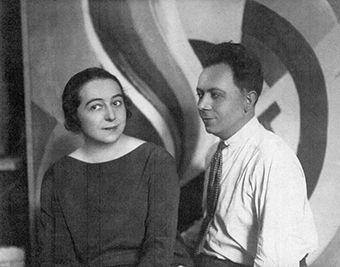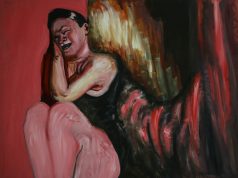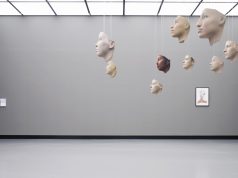Sonia Delaunay (November 14, 1885 – December 5, 1979) was a French painter and textile designer born in Ukraine, who spent most of her life in Paris and was a cofounder of the Orphism art movement along with Robert Delaunay based on strong colors and geometric shapes. Through painstaking historical research Demenok solves the long standing historical mystery of Delaunay’s birthplace in Ukraine. This article is part Yevgeniy Demenok’s Odessa Review column on the history of the Modernist movement in Odessa and Ukraine.
What more can be said about an artist whose name has been entered into every encyclopedia on modern painting? A cavalier of the French order of the Legion of Honor as well as the first living woman to have had a personal exhibit at the Louvre? It might seem like we know everything there is to know about Sonia Delaunay. That was certainly the impression I had when I first began gathering material for an article about Sonia several years ago – but, as it turns out, that impression was completely unfounded.
Sonia Delaunay (born Sara Stern) lived a long, colorful and fascinating life. At the age of five, she was adopted into the family of her maternal uncle, the successful St. Petersburg lawyer Heinrich Terk (she would later take on his family name). Being brought up in a lawyer’s family afforded young Sonia the chance to receive a quality education. During school holidays, she traveled around Europe familiarizing herself with the museums of France, Germany, and Italy. Her talent for painting was noticed by her teacher, and upon his suggestion the eighteen year old Sonia entered the Art Academy in Karlsruhe. After two years, Sonia – now known as Sophie Terk – decided to move to Paris, which was at that time the capital of the European art world. Once there, she entered the La Palette Academy. She was unsatisfied with the academy’s manner of teaching, but she made up for it by spending all her time at the city’s galleries, salons, and studios; as well as embedding herself in the social circles of radical Paris youth.
The young artist was influenced by Van Gogh, Gaugin, Rousseau and the Fauvists in her work. At 23, Sonia married the German gallerist, collector and art critic Wilhelm Uhde, whose work was focused primarily on the primitivist and modern currents in art. The opulent wedding took place in London, but only a year later in 1910, Sonia would leave her husband for the young abstractionist Robert Delaunay (whom she met, ironically enough, through her husband). Despite the unfortunate circumstances in which their love developed, it gave rise to one of the most enduring, romantic and fertile creative partnerships in modern art history. Within a year, Sonia gave birth to a son, Charles (who would go on to become a famous Jazz historian). Amazingly, despite the divorce the Delaunays enjoyed a very warm friendship with Wilhelm Oohed throughout their lives. He would purchase works from Robert as well as Sonia, realizing full well the talent of both artists.
After 1911, she came under the influence of Cubism and departed from the naturalism that she was practicing at the time, as well as a kind of realism in her works in favor of geometrical abstraction. She experimented with visual rhythm and color. In 1913, Guillaume Apollinaire, who introduced the Delaunay spouses to Blaise Cendrars, dubbed the Delaunays’ particular approach to cubism to be “Orphism”. Sonia created the illustrations for Blaise Cendrars’ 1913 cubist poem “Prose of the Trans-Siberian and of Little Jehanne of France”, which remains in print to this day. The basis for the book’s design was the “simultaneism” principle developed in tandem by Sonia and Robert.
Sonia was impressed and influenced by the color experimentation of her husband. She began to create simultaneist canvases alongside Robert, and their works were shown together at exhibitions in Paris, Prague, Berlin, Budapest, Warsaw and America. In the early 1910’s together with Robert she developed the principles of Orphism – a variation on cubism built on emphasizing the vital dynamics of coloration. In 1913, Sonia presents her first Orphist canvases at the Independent Salon.
The First World War forced the couple to relocate from Paris to Spain, and later to Portugal. During their years in exile (1914-1920), the Delaunays formed many friendships with local artists. In Spain, Sonia Delaunay met with Igor Stravinsky, Sergei Dyagilev, and Vaslav Nizhinsky. She would create costume and set designs for Dyagilev’s staging of “Cleopatra”, which was set to the music of A.S. Arensky in 1918. In 1916, Sonia exhibited Cubist and Orphist objets d’art. She had personal exhibitions in Stockholm (1916), Bilbao (1919), and Berlin (1920). At this time she enjoyed a period of great creativity: creating fashion designs for shoes and clothing, designs for playing cards, cars, theater costumes. She created carpets and illustrated books. Sonia ceaselessly switched from one field to another, and enjoyed creative success in everything and anything that she took up.
In 1920, the Delaunays were able to return to Paris. In 1923, together with V. S. Bart and H. Granovsky, Sonia became part of the history of Dadaism when she assisted in the staging of Tristan Tzara’s “The Gas Heart”. In 1925, she participated in the International Decorative Arts Exhibition along with Aleksandra Ekster, Nathan Altman, David Sternberg. Sonia Delaunay also become a master of the Art Deco style, her discoveries being widely used in many areas of decorative art: ceramics, theater design, advertising. She created fabric designs for Lyons factories, and in 1924 together with Jacques Heim she opened the “Simultaneist Boutique” fashion atelier, where she showcased her fashion work, interior designs, fabric patterns, and even automobile designs.
In 1931 Sonia becomes one of the organizers of the “Abstraction – Creation” salon, and in 1939 of the avant-garde “New Reality” salon. She made an immense contribution to the post-war revival of French Abstractionism, preserving her style of vivid spectral dynamics. She also tried her hand at mosaic and stained glass, ceramics, textiles, and book design.
In 1937 Sonia and Robert assisted with the interior design of the French pavilion at the World Fair in Paris. Sonia created a 235 square meter mural for the pavilion, for which she received a gold medal. The next year, she is honored with a large personal retrospective in the Amsterdam City Museum.
Robert Delaunay succumbed to cancer in 1941. Despite the tragedy in her life, Sonia went back to work with redoubled energy. Her aim is to see their joint projects to completion and immortalize her husband by publishing his theoretical works. She also begins writing down her recollections of Robert and their friends – Apollinaire, Picasso, Max Jacob, Fernand Leger, Georges Braque, Aleksandra Ekster, Wassily Kandinsky, Aleksander Arkhipenko, and many others. At all the exhibitions of abstract art which spring up all over post-war Europe, she brought her husband’s works to be shown alongside hers.
In 1963, Sonia gifted 117 canvases authored by herself and Robert to the National Museum of Modern Art. The next year, a lavish ceremony to commemorate the gift took place in the Louvre. Sonia Delaunay became the first ever female artist to have her personal exhibition in the famous museum. This was a significant milestone in the history of art. Her contributions to the art world yielded the recognition that she was due– she became a cavalier of Arts and Literature, received the Paris grand prize for her service to the arts in 1973, and in 1975 received the highest existing award in France – the order of the Legion of Honor.
Sonia died in Paris on December 5, 1979.
In 1985, the Paris Museum of Modern Art hosted an exhibition dedicated to the 100 year anniversary of her birth. Her works are to this day highly appraised by collectors and lovers of art – in 2002 with her painting “Market in Minho” selling for 4.5 million euro and far exceeding the catalog price with a final bid more than five times than the expected reserve price. The painting was purchased by a Russian collector.
While Delaunay’s works are exhibited all over the world, unfortunately, the one country that truly deserves to have one of her paintings and lacks one one of her canvases is her native Ukraine.
It seems that a figure of such scale and fame as Sonia Delaunay should not have any discrepancies or gaps in her biography. However, I encountered them almost instantly in my research. For example, different sources cite different locations of the birth for the artist. Even Wikipedia, one of the most popular internet resources, is still error prone – the article on Delaunay is available in nearly 20 languages, but all the articles are distinctly split into 3 camps on the critical question of where she was born. The Russian, Ukrainian, Italian and Dutch versions all agree that Sara Stern was born in Gradijsk, a town in the Ukrainian region of Poltava. The English version also mentions Gradijsk, but only as a “possible” location of Sonia’s birth. The German, Portuguese, and most importantly, French versions all give the location as “Gradijsk, near Odessa”. However, no town or village with the name Gradijsk exists anywhere near Odessa. The Spanish version confidently cites the artist’s place of birth as Odessa itself. Other reputable internet resources such as Encyclopedia Britannica and various versions of the Jewish Encyclopedia again refer to Gradijsk; but numerous articles about the painter again alternate between Gradijsk and Odessa. Print sources are split as well – for example, TASCHEN’s “Women Artists in the 20 and 21 Century” cite “Gradisk”, while the extensive album “Modern Painting” published by Moscow’s AST/Astrel give the location as “Grazhist, near Odessa”. Getting to the bottom of the matter seems almost impossible.
I became obsessed with the idea of solving this mystery. My first step was to purchase every significant biography of Delaunay available, as well as her only published autobiography which was released in Paris when she was 93 years old. I quickly found that the source of the ambiguity seems to stem from several lines in Delaunay’s autobiographical book, “Nous Irons Jusqu’au Soleil” (“We Follow the Sun”). The book came out in 1978, just one year before the artist’s death, and was written with the help of Jacques Damase and Patrick Reino. On page 12, in the small chapter dedicated to her childhood, Delaunay only once mentions that her father worked at a factory in ”Gradzihsk”. The mention of the town would then make its way into the chronology compiled at the end of the book – listed there as the artist’s place of birth. In the same chronology, her name is given as Sophie instead of Sonia – more chaos! Seeing as there is no town with the name “Gradzihsk” in Ukraine, in further books and articles the places is named as “Gradijsk” – the closest name of an existing city.
One of the best Delaunay biographies was published in New York in 1995. The author, Stanley Barron, worked in collaboration with Jacques Damase, the artist’s friend who also helped her work on her own memoirs. Barron dedicates a similarly brief space to Delaunay’s childhood. He writes: “Most official biographies and catalogues cite the Ukrainian city of Gradijsk on the Dnieper river as the place of her birth; however, in her own book Delaunay only mentions Gradijsk as a city where her father worked. Her last will and testament, which was certified by a notary, gives Odessa as the city of her birth. It is difficult to explain how Odessa came to be replaced by Gradijsk.”
Ukrainian authors Aleksandr Noga and Irina Kodlubai in their spectacular monograph “Sonia Delaunay returns to Ukraine via Lviv” cite documents from the archive of Kyiv art historian Dmitri Gorbachev: an announcement in a 1908 French newspaper about the wedding of Sonia and Wilhelm Uhde, where it is specified that the bride was born to parents Elias and Hannah Stern. A document issued in the same year in St. Petersburg specifies that Sarah Stern was born on November 1, 1885 in Odessa to the family of reserve soldier Elias Stern and Frau Hannah Stern (nee Terk). The Odessa Rabbinate also has a record of the birth. It would seem that this information solves the uncertainty once and for all – but the authors are careful not to rush to conclusions. It remains unexplained why the overwhelming majority of sources list Delaunay’s place of birth as some variation of “Gradijsk”.
It became obvious that there was only one way to establish the truth: refer to the original, authentic documents. I managed to receive archive documents from the regional archives in Odessa and Poltava (Gradijsk has only 7000 residents and does not have its own archive). With the help of one of Odessa’s best local historians, Aleksandr Rozenboym, I obtained the important document which would finally help me tie up the loose ends of this story. This document was none other than a page from the books of the Odessa rabbinate for the day of November 1, 1885 – specifically the section under the header “Births”. The deputy of the St. Petersburg notary responsible for the aforementioned wedding document made a mistake of one number – Entry no. 1173 informs that on this day, Eli Stern and his wife Hannah had a baby girl named Sara. A few months earlier, there is an entry numbered 244 regarding the wedding of Eli Stern to the daughter of Odessa merchant Tovy Terk, Hannah, The wedding was officiated by Rabbi Politkovsky. Elias was 27, and Hannah 22. For both of them, it was their first marriage.
To be completely sure, I first phoned and then made an official request to the Poltava Regional State Archive. I received a verbal response informing me that most of the archival data regarding Jews who were born and lived in Poltava prior to World War II had been destroyed during wartime. I also received an official response in writing which elaborated that the Poltava State Archive had never received data regarding births in the town of Gradijsk, Kremenchug area.
So, where did Gradijsk come from? My theory is that, recalling the distant events of her childhood in her twilight years, Sonia Delaunay made a simple human error. After all, Sonia saw her father only once after moving to her uncle’s home in St. Petersburg, and as for her mother – she never saw her again. She also never returned to Odessa. To be sure, she had vivid and emotional recollections – sparkling deep white snow in the winters, giant yellow sunflowers in the summer, all the bright colors of Ukraine which she would never cease to speak of and which inspired her art. Of course, emotions are much better preserved in our memory than facts. I believe that “Gradijsk” is simply the Russian word for “tiny town” (“gorodishko”) which stuck in little Sonia’s memory and over the years, transformed into a real place in her mind. There is a similar story which occurred with the grandfather of famous French singer Joe Dassin – who, by the way, also hails from Odessa. But that is a whole different story…




































